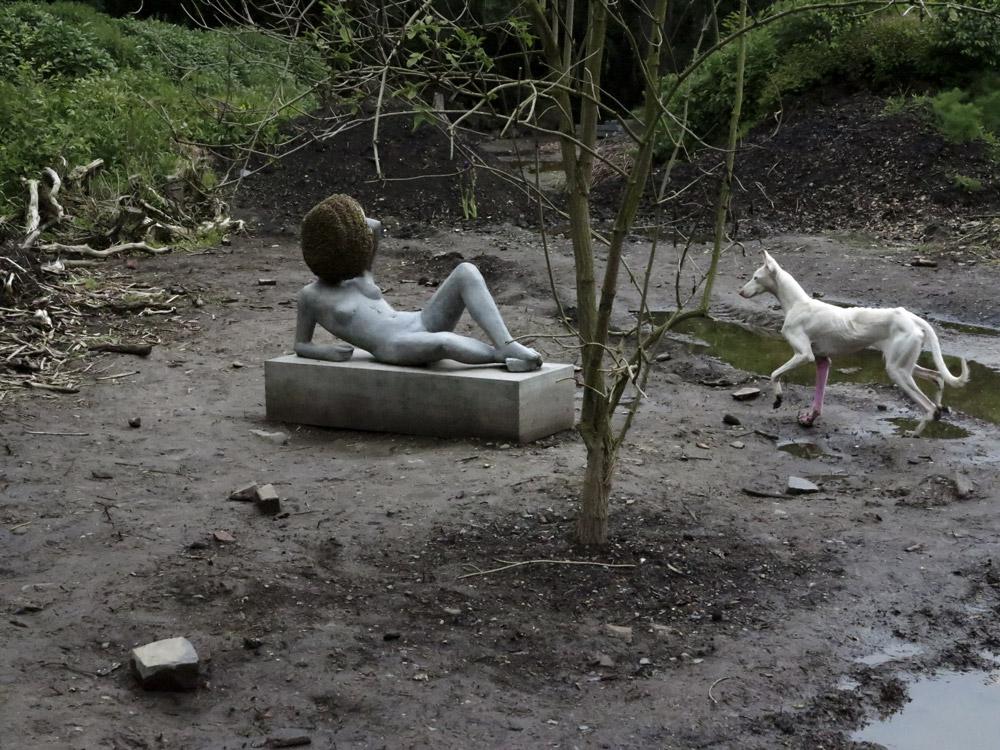Any attempt to put into words the experience of Pierre Huyghe’s retrospective at the Centre Pompidou is bound to fall short. Descriptions of it vary greatly, though each one sounds like a strange waking dream: enter the space and rain or fog or snow falls from the ceiling, a figure skater spins on an ice rink in the space, a live hive of bees swarms the head of a reclining stone figure, a man walks by wearing a mask of light, a dog with a pink leg follows him. And the list goes on, with each new line seeming more surreal than the last.
Is it any surprise that Huyghe, a major figure in the international art world, would stage an unconventional retrospective? It shouldn’t be. Not for the artist who chose the compost facility at end of the Karlsaue Park as the site for his project Untilled (2011–2012) in Documenta 13. Nor for the artist who transformed the Sydney Opera House into a living forest for 24 hours in 2008. Huyghe is well known for his rejection of museum convention in favour of creating live situations, ones increasingly open in recent years to organic and climatic change, populated with plants and animals and insects, and left to evolve outside of the gallery walls or the control of artist.
In this vein, Huyghe has created a world in itself within the Pompidou, essentially transforming the museum into an ecosystem, one that seems indifferent to visitors or to the very idea of art. With more than 50 of the artist’s projects spanning two decades of his practice, the exhibition is a veritable jungle of objects, noises, moving images, and events. Sound bleeds throughout the space. One work morphs into the next. They change in time, evolving and decomposing according to the pace of organic life. In fact, the installation literally “grows” out of the previous ones; the walls from the centre’s prior Mike Kelley show are still largely intact and the green paint from a Guy de Cointet project has been excavated into an abstract landscape entitled Shore (2013).
Few artists who claim to challenge museum conventions have done so this completely and thoroughly. From the unannounced performances—like the crier who might call out your name when you enter (Name Announcer, 2011)—to the spiders and ants crawling into and out of holes drilled into the walls (Umwelt, 2011), every museum rule seems broken. Don’t expect to find wall labels or, if you do, trust them to be leftovers from a previous exhibition.
And while one might think that this deliberate obscurity might make an art exhibition less accessible, it doesn’t. On the contrary, the exhibition has been constantly filled with enthusiastic visitors. Children seem to understand it the best, marvelling at the aquariums and following the pink-legged dog. Huyghe’s anti-retrospective reminds us that art is rooted in time and experience, the real and the imaginary, and that it is always subject to change.

 Pierre Huyghe Untilled 2011–2012 Animals, plants, objects and minerals Dimensions variable Courtesy the artiste, Marian Goodman, New York/Paris and Esther Schipper, Berlin / photo © Pierre Huyghe
Pierre Huyghe Untilled 2011–2012 Animals, plants, objects and minerals Dimensions variable Courtesy the artiste, Marian Goodman, New York/Paris and Esther Schipper, Berlin / photo © Pierre Huyghe







